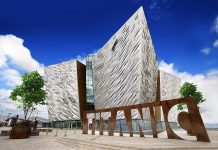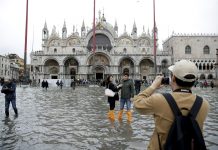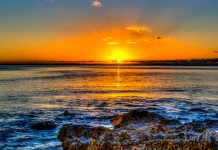This post may contain affiliate links. We may earn money or products from the highlighted keywords or companies or banners mentioned in this post.
01.13.15

Curious eyes followed us as we trekked under tamarind trees on a dirt path that traced the shore of the Mekong River. With villagers watching expectantly, we turned to enter the gates of a 19th-century mansion, a beautifully decaying French-Vietnamese pile near Cai Be. At that moment, a shirtless old man emerged, confused, then began to laugh. “You didn’t tell me you were coming,” he chided our guide, Yee Nguyen, in Vietnamese, throwing on a loose polo shirt. The owner of this architectural relic, it turned out, was Nguyen’s uncle. I couldn’t imagine what the jocular 80-year-old was thinking—with our global group of Italians, Mexicans, Americans, Australians, and French, it’s like the UN showed up at his door—and we were equally surprised to be standing in his living room. A behind-the-scenes tour of this fresco-lined house wasn’t on the day’s agenda, but I’d already come to expect the unexpected on day two of this five-day trip, the inaugural upriver cruise with Aqua Expeditions through Vietnam and Cambodia.
Owned by Italian-American entrepreneur Francesco Galli Zugaro, Aqua has already made a name for itself with its two luxury vessels on the Peruvian Amazon. When customers began clamoring for an Aqua three-peat, Galli Zugaro moved his family to Singapore and, within two years, launched a Mekong river ship with three-, four-, and seven-night itineraries between Ho Chi Minh City, Vietnam, and Siem Reap, Cambodia. (I was on a four-night, two-country itinerary from Ho Chi Minh City to Phnom Penh, Cambodia.)
His timing couldn’t be better. According to the luxury travel-advisor consortium Virtuoso, more than 20 percent of all cruise bookings are now for river ships. Still, there has been more demand than supply. Aqua Mekong distinguishes itself by its size (only 40 passengers); its cuisine, from executive chef David Thompson, who hails from Bangkok’s revered Nahm restaurant; and the access it provides. An impromptu visit with our guide’s uncle was just one of many transporting adventures we had during our cruise, allowing a perspective on rural Asia that until now had been all but inaccessible to travelers.
Three-night cruises from $3,315 per person, double.
The Journey
DAYS 1–2: Bus 45 miles from Ho Chi Minh City to My Tho. Cruise to Cai Be, Binh Thanh, and Tan Chau.
Distance traveled: 83 nautical miles.
Even on the first full day, our excursions began well before dawn, with four private skiffs taking us into narrow channels that zigzagged among single-room houseboats in Cai Be. There, villagers advertised market goods—canary-yellow jackfruit, bumpy durians, sun-dried cassava—on bamboo flagpoles. After a lunch of scallops with caramelized peanuts and stir-fried pork and eggplant on the ship, we toured the fishing village of Binh Thanh (some on the ships’ bikes, which are first come, first served), where houses with open courtyards lifted a curtain on the everyday. Another stop: temples in Sa Dec.

DAY 3: Tan Chau to Phnom Penh.
Distance traveled: 62 nautical miles.
As the Aqua Mekong bobbed alongside tankers and fishing boats waiting to cross the border, we jumped ship to explore the Vietnamese city of Chau Doc. At the local market, residents bartered for clusters of tangy longans and bitter winter melons; smuggled cigarettes (cheap in Vietnam) and liter Coke bottles filled with gasoline (cheap in Cambodia) changed hands clandestinely. Eventually we traded the chaos for the solemnity of the intimate Long Son Tu Temple, high up on Sam Mountain, the region’s tallest peak.
DAYS 4–5: Phnom Penh area.
Distance traveled: 19 nautical miles.
When we toured Koh Dach, just outside of Phnom Penh, we saw women dyeing threads and weaving fine scarves on three-pedaled looms. They were reviving an art form banned under the Khmer Rouge. Our group went to the small village of Okna They to cycle around brick-making factories, temples, and rice farms. White oxen, the preferred mode of transportation, waded in the river, and most houses were still built from thatch and wood. On the following day, we disembarked from Phnom Penh.
The Ship
On the inaugural upriver journey, a handful of features still needed fine-tuning—no water in the pool, a broken toilet handle—but the vessel has since shed its training fins. The location of the spa near the engine room notwithstanding, the Aqua Mekong’s intuitive features and modern Italian style make it the river’s front-runner. It has only 20 staterooms (compared with the usual 40-plus), all equal in size at 322 square feet, giving them a 50-plus-square-foot advantage over other ships’ standard rooms. The contemporary spaces are outfitted with teak furnishings, Nespresso machines, and high- pressure rain showers. All rooms have floor-to-ceiling windows, and eight have glassed-in balconies.

Executive chef David Thompson supplements his Southeast Asian–influenced dishes with produce picked up in markets along the water. His occasional Italian spread is a refreshing break from the native cuisine. House beer and wine is included in ship prices, and at an additional $8, a cocktail won’t break the bank. The Salted Watermelon Crush, made with Sipsmith Barley Vodka and Thai basil, is a standout.
Photos by Tony Law
Also on Travel + Leisure:
Meet Our Local Experts
Best Places to Travel in 2015
When To Cruise Where
Powered by WPeMatico











